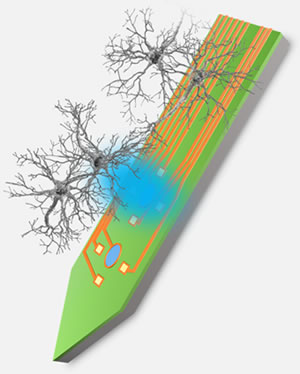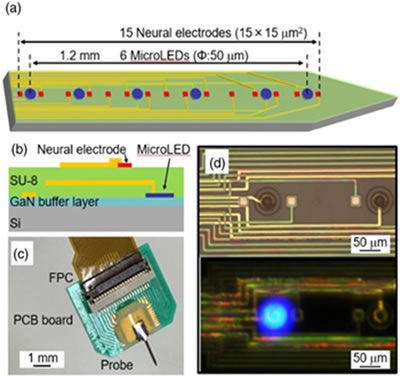
ここからコンテンツです。

MicroLED neural probe for neuroscience
Optogenetic control and recording technology for elucidation of brain functionBy Hiroto Sekiguchi
Associate Professor Hiroto Sekiguchi and Ph.D. candidate Hiroki Yasunaga in the Department of Electrical and Electronic Information Engineering at Toyohashi University of Technology have developed a MicroLED neural probe for use in neuroscience. This MicroLED neural probe can optogenetically control and observe neural activity in the brain. Neural activity was successfully recorded using this neural probe, and confirmed that the MicroLED provided sufficient light output to activate neural activity. The developed MicroLED neural probe is expected to contribute to the development of optogenetic technology in the field of neuroscience, where light can be used to control neurons.
Information processes of advanced brain functions are known to result from complex interactions of interconnected neurons. Optogenetic technology is expected to contribute to elucidating how neural activity and animal behaviors are linked because it uses light to precisely target specific cells for manipulation without affecting other cells in the brain. Previously optical fibers have been inserted in to the brain tissue of mice to control neurons by optical stimulation, there were some issues with damage to the brain tissue as well as some difficulty in stimulating multiple locations.

In the field of engineering, microLEDs, which vary from around one tenth to a hundredth the size of a conventional LED, are increasingly garnering attention thanks to the possibilities they are opening up through the development of high-brightness, highly efficient, and high resolution displays. These displays are created by arranging millions of microLEDs in a single 1cm square. In this study, the research team has fabricated a new device that applies this tiny LED in the field of neuroscience. The micro-LEDs are very small, only a few tens of micrometers square, but they can produce light bright enough to activate nerve cells. This new type of neural probe tool can overcome many of the problems presented by conventional neuroscience tools, and its high spatiotemporal resolution enables us to control and record complex neural activity control.

Associate Professor Hiroto Sekiguchi said, “We have been developing LED materials and researching LED micro-integration technology for more than 10 years. As the industrialization of LEDs progressed, I have been looking for new research fields to utilize these new types of LEDs. In the midst of this, I happened by chance to meet a Pharmacology researcher, and we ended up chatting about our research. Six months later, I received a consultation from the Pharmacology researcher, which led to of this research result. I believe that my simple and easy-to-understand explanations, as well as my active interest in discussing topics across different fields, contributed to the development of this interdisciplinary research project combining pharmacology and engineering.”
The research team hopes to contribute to the development of neuroscience by applying the developed MicroLED neural probe to animal experiments related to in vivo optogenetics research. If the understanding of brain functions is advanced using this tool, it is expected to be utilized for developing treatments for various conditions, such as cancer, psychiatric disorders, and epilepsy. In addition, it is expected to have applications for brain-machine interfaces, and in the field of AI concerned with the development of new algorithms based on brain functions.
This study was partially supported by the Precursory Research for Embryonic Science and Technology Agency (JPMJPR1885), Research Foundation for OptoScience and Technology, and the Nitto Foundation.
Reference
Hiroki Yasunaga, Toshihiro Takagi, Diasuke Shinko, Yusei Nakayama, Yuichi Takeuchi, Atsushi Nishikawa, Alexander Loesing, Mashiro Ohsawa, and Hiroto Sekiguchi (2021). Development of a neural probe integrated with high-efficiency MicroLEDs for in vivo application.
http://dx.doi.org/10.35848/1347-4065/abcffa
神経科学に活用するマイクロLED神経プローブ
脳機能解明に向けた脳神経活動の制御・記録技術By 関口 寛人
豊橋技術科学大学電気・電子情報工学系の関口寛人准教授と博士後期課程の安永弘樹を中心とした研究チームは、神経科学で活用するためのマイクロLED神経プローブを開発しました。この神経プローブはマイクロLEDから発する光を用いて脳神経活動を制御するとともに、記録電極により神経活動をモニタリングすることができます。本研究では、神経プローブを用いてマウスの脳波の取得に成功し、マイクロLEDから神経制御に十分な光出力が得られることを確認しました。開発したマイクロLEDツールは光で神経細胞の制御を可能にする神経科学分野の光遺伝学研究の発展に貢献することが期待されます。
高次脳機能に関連する情報プロセスは絡み合って存在する神経細胞の複雑な相互作用に起因していることが知られています。光遺伝学技術は他の細胞に影響を与えることなく光で特定の神経細胞を正確にコントロールすることができるため、脳神経活動と動物の行動の因果関係の解明に貢献し得る技術として期待されています。従来はマウスの脳組織に光ファイバを刺して光刺激をして神経細胞を制御していましたが、ファイバは太く脳にダメージを与えたり、複数箇所を刺激したりすることが困難でした。
工学分野では「マイクロLED」という従来のLEDよりも1/10、1/100以下となる小さなLEDの集積化技術が注目されており、1cm角の中に数百万個のマイクロLEDを並べることで高輝度・高効率なディスプレイの実現が期待されています。本研究では、この小さなLEDを神経科学分野に活用することを考え、複数のマイクロLEDが集積された神経プローブを開発しました。マイクロLEDは数十μm角ととても小さなものですが、神経細胞を活性化するのに十分な明るい光を作り出すことができます。今回作製したマイクロLEDを活用した神経プローブはこれまでの神経科学ツールの問題を解決でき、高い時空間分解能によって複雑な神経活動制御および記録が可能になります。
「10年以上LEDのための材料開発やLEDの微細集積化技術の研究を進めていましたが、すでに産業化が進みつつあるLEDにおいて、このLEDを発展的に活用するための新たな研究分野を模索していました。そうした中、研究とは関係のない出会いの中で薬学の研究者と出会い、何気ない会話の中で研究の話をしました。半年後、その薬学の研究者から相談をいただき、今回の研究成果につながりました。簡単にわかりやすく説明したことや、異分野のテーマでも積極的に興味を持って話をしたことが、医薬学と工学との融合領域研究に繋がったのではないかと考えています。」 と、関口寛人准教授はこの研究に至った経緯を語っています。
研究チームは、開発したマイクロLED神経プローブを光遺伝学研究に関連する動物実験へと活用して神経科学の発展に貢献していきたいと考えています。本ツールを用いて脳機能の理解が進めば、がんや精神疾患、てんかんの治療法の確立やブレイン・マシン・インターフェースへの応用、脳機能をベースにした新たなアルゴリズム開発を目指すAI分野などの多くの分野へ活用されると期待されます。
本研究の一部は国立研究開発法人科学技術振興機構さきがけ(JPMJPR1885)、公益財団法人光科学技術研究振興財団、および公益財団法人日東学術振興財団の援助を受けて行われました。
Researcher Profile

| Name | Hiroto Sekiguchi |
|---|---|
| Affiliation | Department of Electrical and Electronic Information Engineering |
| Title | Associate Professor |
| Fields of Research | Light-Emitting device, Semiconductor Engineering |
| Degree | Ph. D. (Engineering), Sophia University |
ここでコンテンツ終わりです。
